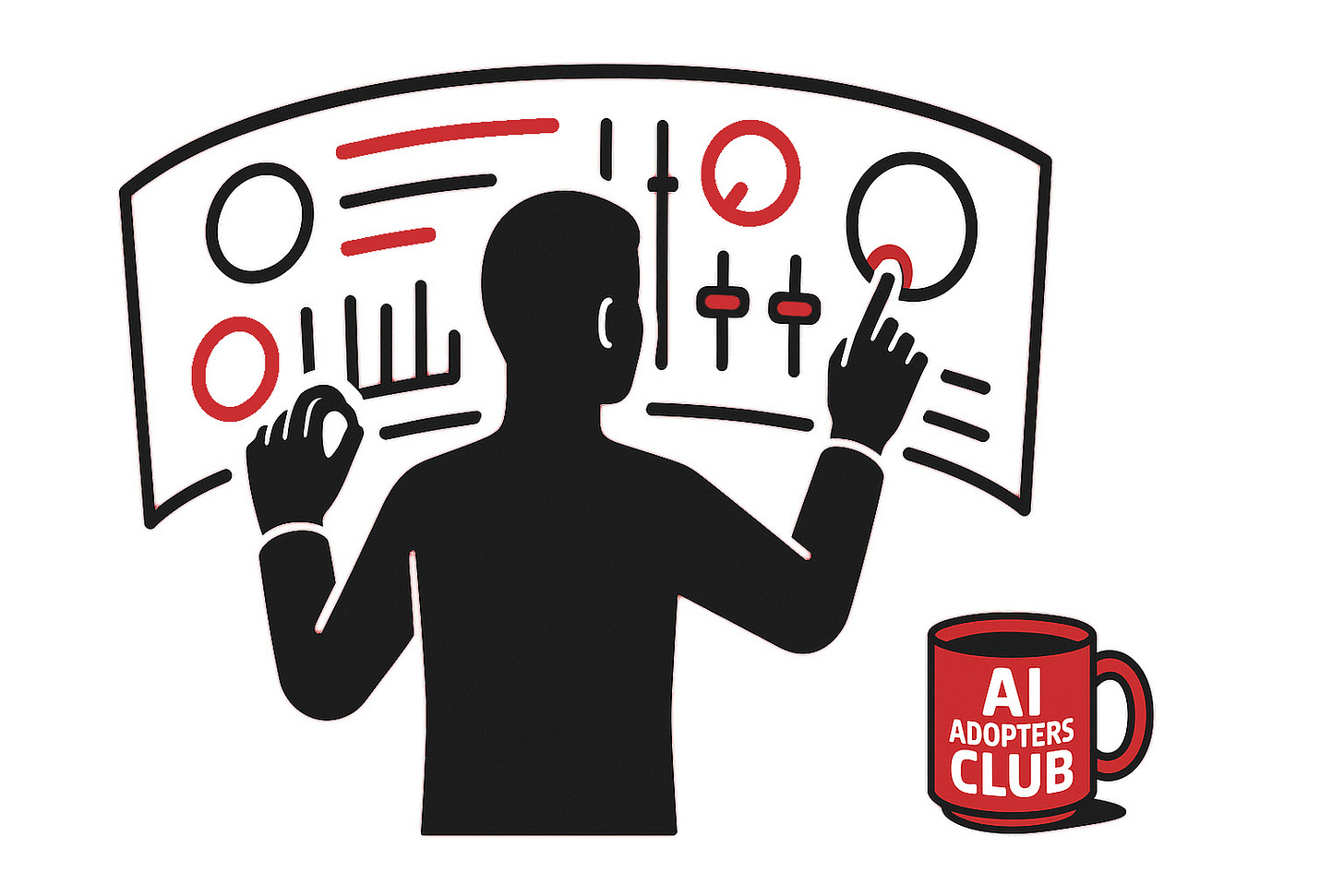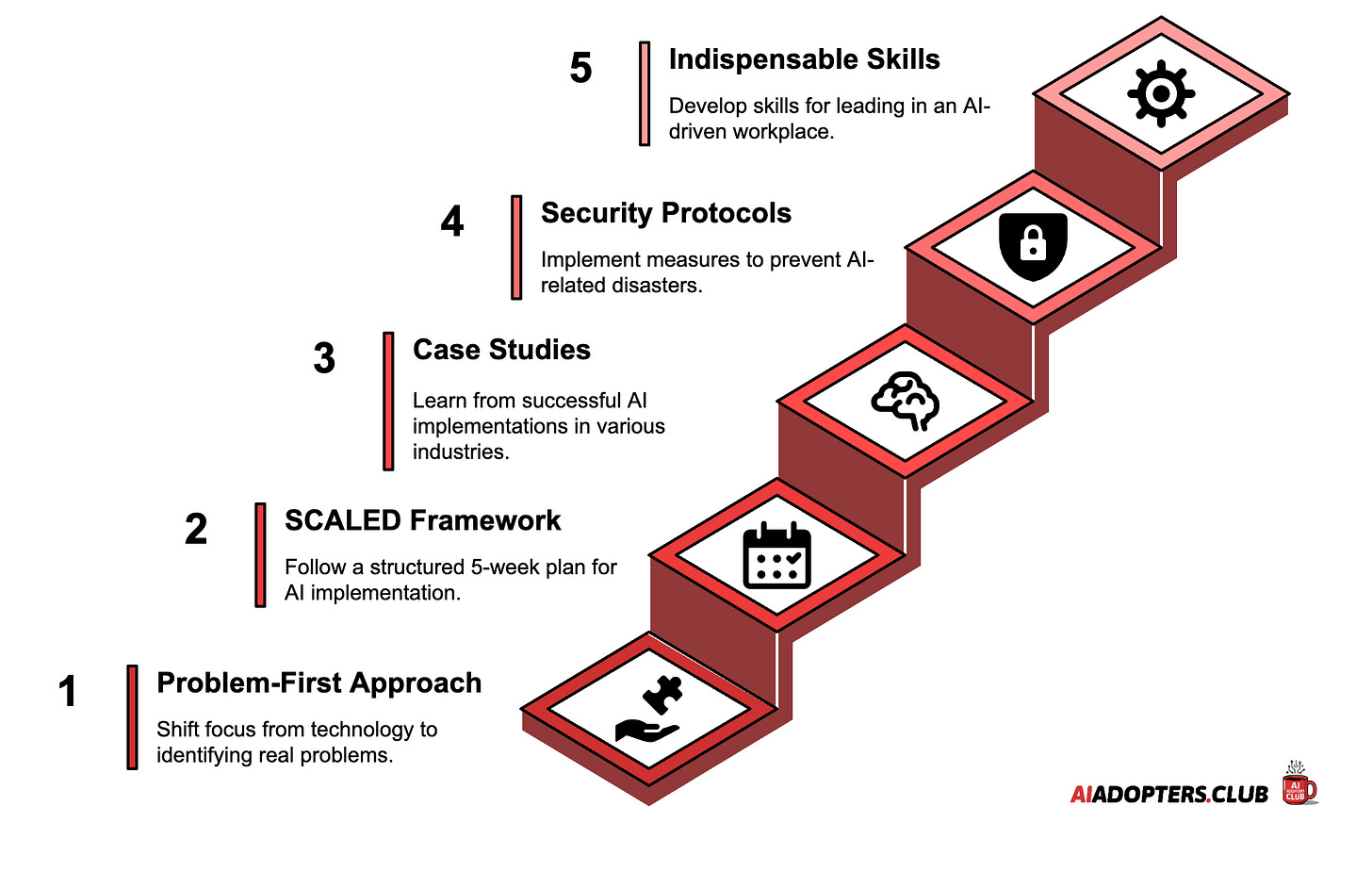The Complete Guide to AI Implementation That Actually Works
From pilot to scale using proven frameworks and real case studies
♥️ Love the AI Adopters Club? Send Us Your Testimonial 🙏
Hey Adopter,
You're about to get the complete playbook for AI implementation that actually delivers results. This isn't another theoretical guide. You're getting battle-tested strategies, real company case studies, and step-by-step frameworks that take you from confusion to confidence.
Most AI guides dump information on you without context. This one is different. I've organized everything around the actual journey you'll take: from identifying opportunities to scaling success. Each section builds on the previous one, giving you a clear path forward.
TLDR: Your AI Implementation Roadmap
The Problem: 85% of AI projects fail because teams chase technology instead of solving real business problems.
The Solution: Use the SCALED framework to move from pilot to scale in 5 weeks. Start with high-impact, low-complexity opportunities. Learn from companies like Bloomberg, Geico, and LinkedIn who've already cracked the code.
Key Actions:
Identify repetitive, time-consuming processes using proven scorecards
Run focused pilots with measurable outcomes
Implement security protocols before problems surface
Scale what works, document what doesn't
Bottom Line: Your competitive advantage comes from implementing AI faster and more effectively than everyone else, not from having the fanciest technology.
How This Guide Works
This article follows the exact sequence you'll use to implement AI successfully:
First, we'll flip your thinking from technology-first to problem-first approach. Then, you'll get the 5-week SCALED framework with specific weekly actions. Next, real company case studies show you what success looks like across different industries. After that, security protocols that prevent disasters before they happen. Finally, the skills and strategies that make you indispensable in an AI-driven workplace.
Each section includes specific tools, templates, and frameworks you can use immediately. No theory. No fluff. Just actionable guidance from organizations that have already solved these problems.
What you'll walk away with: The exact process to identify high-impact AI opportunities, build winning pilot programs, avoid costly mistakes, and scale successfully across your organization. Plus the security protocols and vendor selection criteria that protect your business while driving growth.
Stop Chasing AI Trends, Start Solving Real Problems
Many companies approach AI backwards. They start with the technology and hunt for problems to solve. Smart operators often flip this equation.
Successful organizations typically start with their biggest business pain points. Take Bloomberg, which identified a specific challenge: their analysts needed faster, more accurate financial insights. Their significant AI investment didn't begin with fancy algorithms. It started with understanding exactly what their customers needed most.
The same principle applies whether you're managing a team of five or five thousand. Your AI strategy might work better when it begins with the work that's currently consuming the most human hours. Not the flashiest use case. Not what your competitors are doing. The tasks that drain your team's energy and delay your outcomes.
The SCALED Framework: Your 5-Week Path to Measurable Results
Every successful AI implementation follows a predictable pattern. The SCALED framework gives you the structure to move from idea to impact in five weeks.
Week 1: Scope Your High-Impact Opportunity
Start with the AI process simplification worksheet. This tool helps you identify which processes consume the most repetitive effort and deliver the clearest ROI potential.
Look for tasks that meet three criteria:
High frequency (done multiple times per week)
Clear inputs and outputs (measurable results)
Currently manual or semi-automated
Week 2-3: Choose Your Technology Stack
Size matters, and you're probably doing it wrong. Most organizations pick AI solutions that don't match their scale or complexity needs. A 50-person company needs different tools than a 5,000-person enterprise.
Use the automation economics business size guide to match your solution to your scale. Small teams often need plug-and-play tools. Large enterprises require custom integrations.
Week 4: Run Your Pilot Program
Keep your pilot narrow and measurable. LinkedIn transformed their recruitment process by starting with a single use case: automating candidate sourcing for technical roles. Their focused approach delivered measurable results within 30 days.
Week 5: Document and Scale
Capture everything that worked and everything that didn't. Your pilot documentation becomes your scaling playbook.
Learn from the Companies Getting It Right
The best way to build your AI strategy is studying organizations that have already cracked the code.
The Insurance Industry's AI Revolution
Geico turned AI into a $78 billion competitive advantage by focusing on customer experience optimization rather than cost-cutting. Their approach: identify every customer friction point, then deploy AI to eliminate those specific pain points.
The lesson: AI isn't just about efficiency. It's about delivering experiences your competitors can't match.
Retail's Personalization Breakthrough
Ulta Beauty cracked the personalization code by using AI to predict which products customers want before they know they want them. Their secret: combining purchase history with behavioral data to create truly predictive recommendations.
Enterprise Software's Strategic Shift
ADP's enterprise AI strategy reveals how large organizations successfully integrate AI across multiple business units. Their key insight: start with employee-facing tools before customer-facing applications.
Navigate the Security Minefield Before It Explodes
AI security isn't optional anymore. Recent analysis of OpenAI's agent security risks shows that even well-designed AI systems can create unexpected vulnerabilities.
The Three Non-Negotiable Security Protocols
Data boundary enforcement. Never feed sensitive customer data to third-party AI tools without explicit data processing agreements.
Access control implementation. Tools for using AI safely at work include role-based permissions and audit trails for every AI interaction.
Human oversight requirements. Every AI decision that affects customers, employees, or business operations needs human review before execution.
Master the Skills That Make You Indispensable
The AI skills gap is creating massive career opportunities for those who know how to bridge technology and business value. The five AI skills making professionals indispensable aren't technical skills. They're business translation skills.
Skill 1: AI-Human Collaboration
Learn to work with AI without losing your edge. Using AI without getting dumber requires understanding when to rely on AI and when to trust your human judgment.
Skill 2: Cross-Functional Communication
Become the translator between technical teams and business stakeholders. This template email shows you how to communicate AI initiatives in language that gets executive buy-in.
Skill 3: Strategic AI Leadership
Position yourself as your company's AI transformation leader. Leading your company's AI transformation requires understanding change management as much as AI capabilities.
Avoid the Mistakes That Kill 85% of AI Projects
The statistics are brutal. 85% of AI projects fail, and most failures follow predictable patterns.
The Top Project Killers
Myth-driven decision making. Ten AI myths are actively killing businesses by leading teams to pursue impossible goals or ignore real limitations.
Government-style waste. The US government's AI spending reveals how bureaucratic procurement processes select the wrong vendors for the wrong reasons.
Scale mismatches. Companies try to implement enterprise solutions when they need simple automation, or vice versa.
Industry-Specific Success Stories You Can Adapt
AI success looks different across industries, but the underlying principles remain consistent.
The Fragrance Industry's Digital Transformation
AI in the fragrance industry shows how even traditional, artisanal businesses can benefit from algorithmic optimization. The key: using AI to enhance human creativity rather than replace it.
Automotive's Competitive AI Race
BMW versus Mercedes in the AI arena demonstrates how companies in the same industry can take radically different approaches to AI integration, with measurably different results.
Music Streaming's AI-Driven Growth
Spotify's AI strategy reveals how companies use AI not just for recommendations, but for content creation, artist development, and platform optimization.
Build Your AI Advisory Practice
For consultants, AI represents the biggest service expansion opportunity in decades. Building a six-figure fractional CAIO practice doesn't require technical skills. It requires business strategy skills.
The Consultant's Advantage
You already have the most valuable AI skill: business problem identification. Companies don't need more AI experts. They need professionals who can translate business challenges into AI opportunities.
The strategic framework behind every successful AI consultant combines industry knowledge with implementation expertise.
The Future Belongs to the Prepared
AI adoption isn't slowing down. Analysis of recent industry developments shows that the companies investing now will have insurmountable advantages over those waiting for "better" technology.
Your move is simple: start small, think big, move fast.
Pick one process that's currently eating up your team's time. Apply the SCALED framework. Document everything. Scale what works.
The organizations getting AI right aren't the ones with the biggest budgets or the most technical expertise. They're the ones that started solving real problems with available tools.
Your competitive advantage isn't coming from the technology. It's coming from your ability to implement that technology faster and more effectively than everyone else.
Time to stop planning and start building.
Adapt & Create,
Kamil







This seems well thought out but from business owners I talk with considering AI the first hurdle is the Owner/CEO understanding how to use AI to do their job easier.
When they see personal use cases, it filters down Into the org.